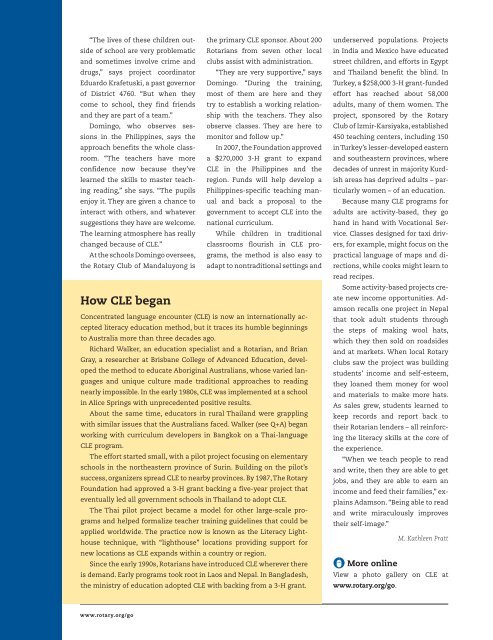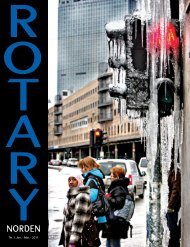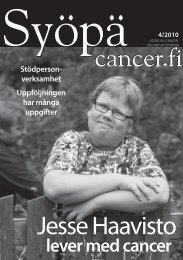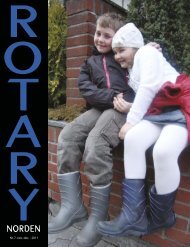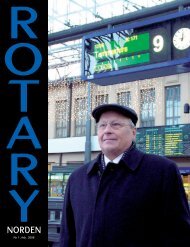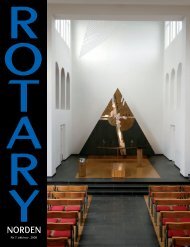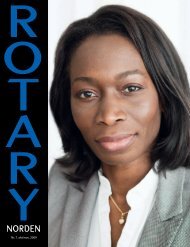You also want an ePaper? Increase the reach of your titles
YUMPU automatically turns print PDFs into web optimized ePapers that Google loves.
“The lives of these children out-<br />
side of school are very problematic<br />
and sometimes involve crime and<br />
drugs,” says project coordinator<br />
Eduardo Krafetuski, a past governor<br />
of District 4760. “But when they<br />
come to school, they find friends<br />
and they are part of a team.”<br />
Domingo, who observes ses-<br />
sions in the Philippines, says the<br />
approach benefits the whole class-<br />
room. “The teachers have more<br />
confidence now because they’ve<br />
learned the skills to master teach-<br />
ing reading,” she says. “The pupils<br />
enjoy it. They are given a chance to<br />
interact with others, and whatever<br />
suggestions they have are welcome.<br />
The learning atmosphere has really<br />
changed because of CLE.”<br />
At the schools Domingo oversees,<br />
the Rotary Club of Mandaluyong is<br />
How CLE began<br />
www.rotary.org/go<br />
the primary CLE sponsor. About 200<br />
Rotarians from seven other local<br />
clubs assist with administration.<br />
“They are very supportive,” says<br />
Domingo. “During the training,<br />
most of them are here and they<br />
try to establish a working relation-<br />
ship with the teachers. They also<br />
observe classes. They are here to<br />
monitor and follow up.”<br />
In 2007, the Foundation approved<br />
a $270,000 3-H grant to expand<br />
CLE in the Philippines and the<br />
region. Funds will help develop a<br />
Philippines-specific teaching manual<br />
and back a proposal to the<br />
government to accept CLE into the<br />
national curriculum.<br />
While children in traditional<br />
classrooms flourish in CLE programs,<br />
the method is also easy to<br />
adapt to nontraditional settings and<br />
Concentrated language encounter (CLE) is now an internationally accepted<br />
literacy education method, but it traces its humble beginnings<br />
to Australia more than three decades ago.<br />
Richard Walker, an education specialist and a Rotarian, and Brian<br />
Gray, a researcher at Brisbane College of Advanced Education, developed<br />
the method to educate Aboriginal Australians, whose varied languages<br />
and unique culture made traditional approaches to reading<br />
nearly impossible. In the early 1980s, CLE was implemented at a school<br />
in Alice Springs with unprecedented positive results.<br />
About the same time, educators in rural Thailand were grappling<br />
with similar issues that the Australians faced. Walker (see Q+A) began<br />
working with curriculum developers in Bangkok on a Thai-language<br />
CLE program.<br />
The effort started small, with a pilot project focusing on elementary<br />
schools in the northeastern province of Surin. Building on the pilot’s<br />
success, organizers spread CLE to nearby provinces. By 1987, The Rotary<br />
Foundation had approved a 3-H grant backing a five-year project that<br />
eventually led all government schools in Thailand to adopt CLE.<br />
The Thai pilot project became a model for other large-scale programs<br />
and helped formalize teacher training guidelines that could be<br />
applied worldwide. The practice now is known as the Literacy Lighthouse<br />
technique, with “lighthouse” locations providing support for<br />
new locations as CLE expands within a country or region.<br />
Since the early 1990s, Rotarians have introduced CLE wherever there<br />
is demand. Early programs took root in Laos and Nepal. In Bangladesh,<br />
the ministry of education adopted CLE with backing from a 3-H grant.<br />
underserved populations. Projects<br />
in India and Mexico have educated<br />
street children, and efforts in Egypt<br />
and Thailand benefit the blind. In<br />
Turkey, a $258,000 3-H grant-funded<br />
effort has reached about 58,000<br />
adults, many of them women. The<br />
project, sponsored by the Rotary<br />
Club of Izmir-Karsiyaka, established<br />
450 teaching centers, including 150<br />
in Turkey’s lesser-developed eastern<br />
and southeastern provinces, where<br />
decades of unrest in majority Kurdish<br />
areas has deprived adults – particularly<br />
women – of an education.<br />
Because many CLE programs for<br />
adults are activity-based, they go<br />
hand in hand with Vocational Service.<br />
Classes designed for taxi drivers,<br />
for example, might focus on the<br />
practical language of maps and directions,<br />
while cooks might learn to<br />
read recipes.<br />
Some activity-based projects create<br />
new income opportunities. Adamson<br />
recalls one project in Nepal<br />
that took adult students through<br />
the steps of making wool hats,<br />
which they then sold on roadsides<br />
and at markets. When local Rotary<br />
clubs saw the project was building<br />
students’ income and self-esteem,<br />
they loaned them money for wool<br />
and materials to make more hats.<br />
As sales grew, students learned to<br />
keep records and report back to<br />
their Rotarian lenders – all reinforcing<br />
the literacy skills at the core of<br />
the experience.<br />
“When we teach people to read<br />
and write, then they are able to get<br />
jobs, and they are able to earn an<br />
income and feed their families,” explains<br />
Adamson. “Being able to read<br />
and write miraculously improves<br />
their self-image.”<br />
M. Kathleen Pratt<br />
More online<br />
View a photo gallery on CLE at<br />
www.rotary.org/go.


